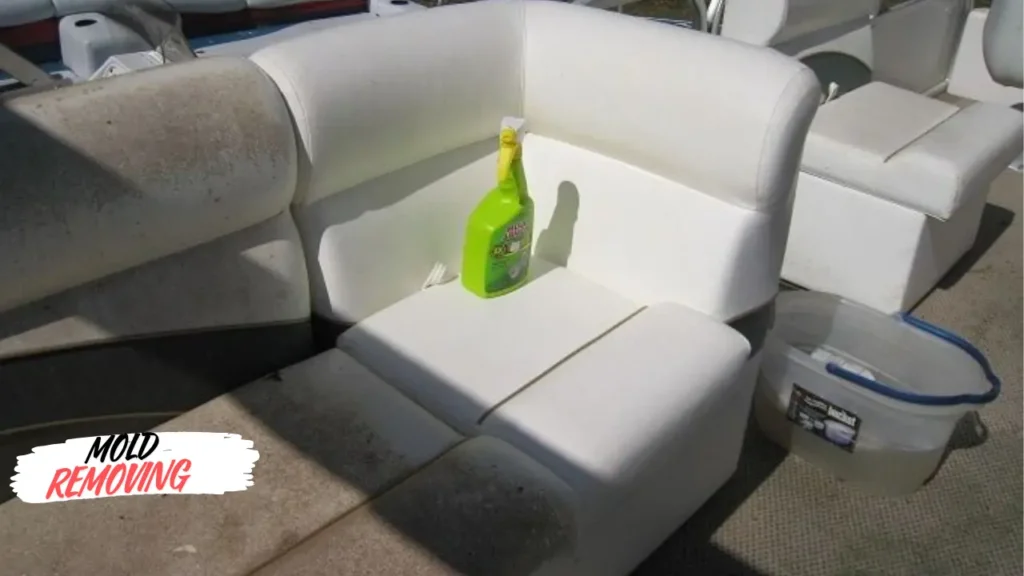Mold thrives in damp, dark environments, making boat seats a prime target. Whether it’s due to moisture accumulation, inadequate ventilation, or improper storage, mold can quickly colonize boat upholstery if not addressed promptly.
Causes of Mold Growth
- Humidity and Moisture
High humidity levels, especially in marine environments, create conducive conditions for mold growth.
- Lack of Ventilation
Poor airflow within the boat cabin or storage area can trap moisture, promoting mold development.
- Storage Conditions
Improperly storing the boat without adequate ventilation or protection exposes seats to moisture, facilitating mold growth.
Preventive Measures
Regular maintenance and preventive measures can significantly reduce the likelihood of mold infestation on boat seats.
- Regular Cleaning
Frequent cleaning with mild detergent and water helps prevent mold spores from settling and thriving on seats.
- Proper Ventilation
Ensuring adequate airflow within the boat interior aids in drying out moisture, discouraging mold growth.
- Use of Protective Covers
Covering boat seats when not in use shields them from moisture and UV exposure, minimizing mold risk.
Identifying Mold on Boat Seats
Recognizing the signs of mold early is crucial for timely intervention and mitigation.
- Visual Inspection
Inspect seats for fuzzy patches, black spots, or any visible signs of mold growth.
- Musty Odor
A musty, damp smell emanating from seats often indicates mold presence.
- Discoloration
Unusual discoloration or staining on seat upholstery may signify mold colonization.
DIY Methods for Removing Mold
Several household items can effectively eliminate mold from boat seats.
- Vinegar Solution
A mixture of equal parts white vinegar and water applied to affected areas can kill mold spores and inhibit further growth.
- Baking Soda Paste
Baking soda paste, made by mixing baking soda with water, is effective for scrubbing away mold stains.
- Hydrogen Peroxide Solution
Hydrogen peroxide diluted with water can serve as a potent mold remover without harming boat upholstery.
Commercial Mold Removers
Specialized mold removal products offer convenience and efficacy in tackling stubborn mold infestations.
- Sprays
Mold removal sprays are convenient for spot treatments and penetrating deep into fabric fibers.
- Foams
Foam-based mold removers adhere to vertical surfaces, making them ideal for boat seat upholstery.
- Wipes
Pre-moistened wipes are handy for quick mold removal on smaller surface areas.
Cleaning Products and Tools Required
Gather the necessary supplies before embarking on mold removal to ensure a smooth and effective cleaning process.
- Soft Bristle Brush
A soft-bristled brush helps dislodge mold from fabric without causing damage.
- Microfiber Cloths
Lint-free microfiber cloths are ideal for wiping away mold residues without leaving behind lint or scratches.
- Protective Gloves
Wear protective gloves to shield your hands from direct contact with cleaning solutions.

Step-by-Step Guide for Mold Removal
Follow these steps for thorough mold removal from boat seats:
- Preparation
Ventilate the boat cabin and don protective gear, including gloves and a mask.
- Application of Cleaning Solution
Apply the chosen cleaning solution liberally to mold-infested areas, ensuring thorough coverage.
- Scrubbing and Wiping
Gently scrub the seats with a soft brush or cloth to loosen mold residues, then wipe away the debris.
- Rinsing and Drying
Rinse the seats with clean water to remove any remaining cleaning solution, then allow them to air dry completely.
Tips for Effective Mold Removal
Enhance the efficacy of mold removal efforts with these practical tips:
- Test in a Small Area
Before applying any cleaning solution, test it on a small, inconspicuous area of the seat to ensure compatibility.
- Avoid Harsh Chemicals
Opt for mild, eco-friendly cleaners to protect both the environment and boat upholstery.
- Protective Gear
Always wear protective gear, including gloves and a mask, when handling mold removal products to minimize exposure risks.
Check this blog : How to Remove Mold from Closet
Post-Removal Maintenance
After successfully removing mold from boat seats, implement preventive measures to maintain a mold-free environment.
- Regular Inspections
Periodically inspect boat seats for signs of mold growth and address any issues promptly.
- Proper Storage
Store the boat in a dry, well-ventilated area, and consider using moisture-absorbing products to prevent mold recurrence.
Professional Mold Removal Services
In cases of severe mold infestation or persistent mold problems, seeking professional mold removal services may be necessary.
- When to Seek Professional Help
If DIY methods prove ineffective or if mold growth is extensive, consult a professional mold remediation specialist for thorough removal and prevention.
- Cost Considerations
The cost of professional mold removal services varies depending on the severity of the infestation and the size of the affected area.
Environmental Impact and Safety
When choosing mold removal products, consider their environmental impact and prioritize safety.
- Eco-Friendly Alternatives
Opt for eco-friendly mold removal solutions to minimize harm to the environment and aquatic life.
- Disposal of Cleaning Materials
Dispose of used cleaning materials responsibly, following local regulations and guidelines.
Common Mistakes to Avoid
Avoid these common pitfalls when dealing with mold on boat seats:
- Ignoring Early Signs of Mold
Address mold issues promptly to prevent them from worsening and causing extensive damage.
- Using Excessive Force
Avoid aggressive scrubbing or abrasive cleaning methods that may damage boat upholstery.
- Incomplete Drying
Ensure seats are thoroughly dried after cleaning to prevent mold recurrence.
Conclusion
Removing mold from boat seats is a necessary task for maintaining a clean and healthy boating environment. By following proper cleaning techniques and preventive measures, boaters can effectively eradicate mold and enjoy their time on the water without worrying about mold-related issues.
FAQs
Q1: Can mold on boat seats cause health problems? A1: Yes, prolonged exposure to mold spores can lead to respiratory issues and allergic reactions.
Q2: How often should boat seats be inspected for mold? A2: It’s advisable to inspect boat seats for mold at least once a month, especially during humid weather or after periods of storage.
Q3: Can I use bleach to remove mold from boat seats? A3: While bleach is effective against mold, it can also damage boat upholstery and pose environmental risks, so it’s best to opt for safer alternatives.
Q4: Are there any natural remedies for removing mold from boat seats? A4: Yes, vinegar, baking soda, and hydrogen peroxide are natural remedies that can effectively remove mold from boat seats.
Q5: How long does it take to remove mold from boat seats using DIY methods? A5: The time required for mold removal depends on the severity of the infestation and the chosen cleaning method but typically ranges from a few hours to a day.

